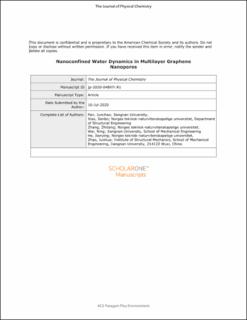| dc.description.abstract | Water dynamics in frictionless carbon nanotubes and across ultrathin graphene nanopores have been extensively studied. In contrast, the fundamental properties of nanoconfined water in multilayer graphene nanopores (MGPNs), namely nanopores with rough inner wall, are yet not explored. In this study, nanoconfined water in MGPNs with diameter D ranging from 0.82 to 3.4 nm were investigated by molecular dynamic simulations, providing key dynamics parameters including diffusion coefficient, friction coefficient and shear viscosity. The confinement effect of MGPNs was fully revealed, which indicated a critical pore diameter (Dc) of 1.36 nm determining internal water structure and dynamics. Confined water in MGPNs with diameter smaller than or equal to Dc exhibited layer structure and abnormal diffusion. For better understanding water dynamics in MGPNs, water flux and flow enhancement factor were characterized. All the calculated structural and dynamics properties of nanoconfined water in MGPNs were also compared with published results obtained from carbon nanotubes with similar sizes, which for the first time unveiled the impact of inner wall topology of nanopore on nanoconfined water. The results of this study thus laid the solid basis of potential applications of MGPNs and other nanopores with rough inner wall in adsorption and separation of complex fluids, DNA sequencing, seawater desalination, and many others. | en_US |
